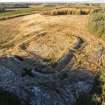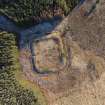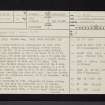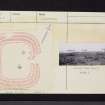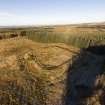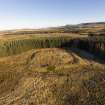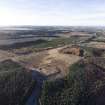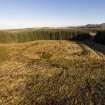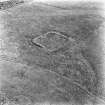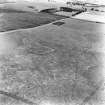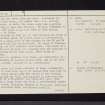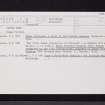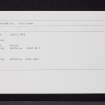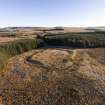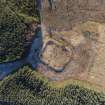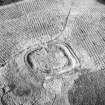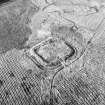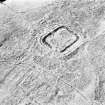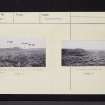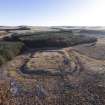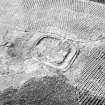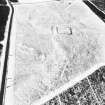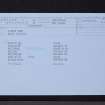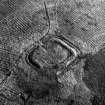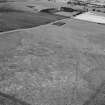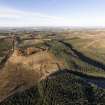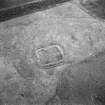Castle Greg
Fortlet (Roman)
Site Name Castle Greg
Classification Fortlet (Roman)
Canmore ID 48988
Site Number NT05NE 1
NGR NT 05020 59250
Datum OSGB36 - NGR
Permalink http://canmore.org.uk/site/48988
- Council West Lothian
- Parish Mid Calder
- Former Region Lothian
- Former District West Lothian
- Former County Midlothian
NT05NE 1 05020 59250
(NT 0501 5925) Castle Greg (NAT) Roman Fortlet (R)
OS 6" map (1961)
A one-eighth mark of James VI, 1601, found "at the Roman Camp, Harburn," was donated to the National Museum of Antiquities of Scotland (NMAS) in 1853 by J Cochrane, Harburn.
Proc Soc Antiq Scot 1855
Many coins and other articles of Roman workmanship are said to have been dug up at Castle Greg from time to time. A round hollow near the centre of the fortlet, locally called the Well, but supposed to have been the foundation of a flagstaff, was excavated about 1830, when under a large stone was found a considerable number of Roman coins, including denarii of Vespasian, Domitian, Hadrian, Antoninus Pius, and Marcus Aurelius, indicating a date of about 170 AD. Some of the coins were sold to a goldsmith in Edinburgh, but the remainder were in the possession of the proprietor, Mr Young of Harburn, who presented a complete set of the coins to Charles X of France in 1832.
Further excavations were carried out in 1846 by Mr Cochrane of Harburn, who found fragments of Roman pottery.
H B M'Call 1894
This Roman fortlet is rectangular in plan, with rounded corners, measuring internally between crests 180ft by 152ft. It is surrounded by a well-defined rampart, best preserved at the S end where it is 28ft wide, rising 4ft above the interior, and 7ft above the ditch immediately in front: 7ft away is a second ditch, both ditches being 8 ft wide and 2 1/2 ft deep. They surround the fortlet except in the centre of the E side, where there is a 22ft wide causeway, leading to a 9ft gap in the rampart. Some 28ft N of this entrance is an oval hollow, possibly the site of a hut. Near the centre of the fort is a circular hollow, 12ft in diameter, which contained a well.
When excavated in 1851, fragments of Roman pottery were found; the well was excavated to 11ft without anything being found, but it was said by an old local inhabitant that about 1810, a "bull's hide" filled with silver coins was taken from the well. Macdonald (1918) discounts this story, but quotes the Statistical Account (OSA), stating several coins, on which the Roman eagle was apparent, had been dug up near this fortlet. If this statement is accurate, the coins could have been of Mark Antony, Vespasian, or Titus.
When visited by the OS in 1953 (JLD, 25 February 1953 and FDC, 9 May 1953) this fortlet was found to be as described above, in a fair state of preservation except for a small part of the ditches at the NW and SW angles which had all but vanished. No signs of internal habitation, or of a tutulus, were found. The track of a road could also be made out, running from the entrance in the E, curving NE for some 40.0m, after which it disappeared.
T H Holbert's notes (19, Thomson Drive, Currie, 23 May 1964) mention that there are indications of a track ascending SW towards Castle Greg, and of the exit from the gateway, visible on air photographs (RAF/541/A/ 393:3451, F58/RAF/3544:0197).
R G Collingwood and I Richmond 1969; RCAHMS 1929, visited 1914; D Wilson 1855; OSA 1796
No change to the previous field report.
Surveyed at 1/10,000.
Visited by OS (MJF) 24 April 1979
Inspection of RCAHMS aerial photographs, shows that the E-facing gate has a 'parrot's beak', indicative of a Flavian date.
S S Frere 1989
Field Visit (28 April 1914)
Castle Greg, Camilty Hill.
Some 50 yards south of the summit of Camilty Hill, occupying a slight plateau on the crest of a broad ridge of moorland, and about three quarters of a mile south-east of Harburnhead farm steading, at an elevation of almost 900 feet above sea-level, is a fort, rectangular in shape with rounded corners, the main axis running north-north-west and south-south-east. Internally it measures between crests 180 feet in length and 152 feet in breadth. It is surrounded by a well-defined rampart, best preserved at the south end, where it shows a width of 28 feet and rises 4 feet above the interior and 7 feet above the ditch immediately in front. Two ditches, 8 feet in breadth and 2 ½ feet in depth, with an intermediate mound 7 feet in breadth, rising in height only to the general level of the ground outside, entirely surround the fort, except at the centre of the eastern flank. There the line of the ditches is interrupted by a roadway 22 feet in width, which passes through the inner rampart, in an opening 9 feet broad. On the north side of the entrance the main rampart terminates in a mound, 16 feet broad and 2 feet in height, which returns 20 feet towards the interior. Some 28 feet north of the entrance, at the base of the inner slope of the rampart, is an oval hollow, perhaps the site of a hut, 9 feet in length, 6 feet in breadth, and 9 inches in depth. Near the centre of the fort is a circular hollow, 12 feet in diameter, which apparently contained a well.
This well was excavated by Sir Daniel Wilson in 1852 to a depth of about eleven feet, without anything of importance being discovered, but elsewhere in the camp there were found ‘numerous remains of Roman glass, mortaria, amphorre, etc., all in a fragmentary condition, with some fragments of iron weapons, and a portion of a lead vessel. . .. Among the glass, were the handle, neck, and considerable remains of an unusually large glass jar, of the square form frequently found on Roman sites’ (Proc. Soc. Ant. Scot., i (1851-4), pp. 58-9).
To judge from Wilson's description of the objects found during his excavation it seems probable that the fort was a Roman one, a conclusion suggested also by its shape.
Coin finds from the neighbourhood of the camp have been described in Proc. Soc. Ant. Scot., lii (1917-18), p. 221.
RCAHMS 1929, visited 28 April 1914.
OS map: xi S.E. ("Roman Camp").
Publication Account (1985)
This is a fortlet rather than a full-sized fort. Standing close to 275m above sea-level, on a slight plateau amongst what formerly were mainly peat-mosses, it may indicate the presence of a minor Roman route west of the Pentland Hills, used perhaps for troop movements into Lothian from forts or fortlets at Carstairs and Carnwath close to the River Clyde. That no such road is known, however, may suggest early construction, before the proper establishment of the Roman road network.
Almost intact, the fortlet is rectangular (some 55m by 46m) with rounded corners and a well-defined rampart that is best preserved at the southern end. Two ditches, with a mound between, surround the rampart except at the gateway in the centre of the east side. The roadway is some 6.7m wide at the ditches, narrowing to about 2.7m where it passes through the rampart, whilst near to the centre a roughly circular hollow marks the site of a well. The fortlet could have held about 80 men.
Information from 'Exploring Scotland's Heritage: Lothian and Borders', (1985).
Earth Resistance Survey (24 March 2012 - 25 March 2012)
NT 05020 59250 A ground resistance survey was carried out 24–25 March 2012 over the fort platform and defences of Castle Greg Roman fortlet. The site is located in Camilty Forest and has been dated to the 1st century AD on the basis of the incurved ‘parrot’s beak’ ditch terminal at the E gate. Excavations in 1830 and 1851 found coins, a well and the stone base of a flagstaff.
The survey clearly recorded the lines of the rampart, double ditches and upcast and revealed some internal anomalies, including internal roadways and high resistance ‘blobs’ which may be ovens built into the inner part of the rampart. Additional interpretation of the results identified a continuation of ditch lines, which might be associated with a possible annex, and this may be the subject of further survey.
Archive: RCAHMS, West Lothian Council Local History Library and WoSAS
Funder: Historic Scotland, Forestry Commission Scotland and Edinburgh Archaeological Field Society
Ian Hawkins, Edinburgh Archaeological Field Society
Donald Matthews,
2012
Earth Resistance Survey (26 October 2013)
NT 05020 59250 A ground resistance survey was carried out on 26 October 2013 on areas to the NE and NW of the Castle Greg Roman fortlet, where previous work (DES 2013, 182–3) had suggested the presence of a possible annexe. Two 20 x 20m grids and three partial grids running to the forest edge were surveyed. The results indicated that the spur from the outer ditch at the NE corner did continue, but veered off to the NE making it unlikely that there was an external defended area, although it is feasible that there could have been an annexe under the present forested area. A 3.8m wide area of higher resistance could be a trace of the road exiting the fort from the E gate towards the supposed line of the Roman Road to the N of the fortlet.
Archive: Forestry Commission Scotland, RCAHMS, West Lothian Council History Library and WoSAS (intended)
Funder: Historic Scotland, Forestry Commission Scotland and Edinburgh Archaeological Field Society
Ian Hawkins, Edinburgh Archaeological Field Society, 2013
(Source: DES)
Measured Survey (3 February 2014)
NT 05030 59252 A detailed topographic survey was undertaken of the surviving remains of a Roman fortlet at Castle Greg on 3 February 2014. The survey allowed the creation of a digital terrain model, contour-based plans and oblique terrain models of the site within its landscape setting, which will be utilised to inform future conservation and management of the monument by Forestry Commission Scotland. It was one of a group of six
such surveys carried out on Forestry Commission Scotland sites in February 2014. The other sites were at Round Dounan, Craig Phadrig, Sean Craig, Dun Deardail and Torr Dhuin.
Archive: RCAHMS (intended)
Funder: Forestry Commission Scotland
Louise Baker and Enda O’Flaherty – Rubicon Heritage Services
(Source: DES)
Project (21 July 2022 - 22 July 2022)
Historic Environment Scotland (HES), Heritage Recording and Archaeology Service (HeRAS), undertook a geophysical (gradiometer and electro-magnetic) survey at Castle Greg Roman fortlet, Camilty Plantation, West Lothian, Scotland, using a Sensys MXPDA system and a hand-held GF Instruments CMD Mini Explorer.
The survey results are summarised below, drawing out the main points from a comprehensive report outlining the methodology and detailed results [1]. The archive also includes the unprocessed survey data, processed survey data [2], survey area extents which contain the survey metadata, and point, line, and polygon interpretations [3].
The survey within the fortlet has identified two possible buildings, an area of burning, a possible oven set into the rampart and rampart core material.
Archive: NHRE
Funder: Historic Scotland Foundation
Hazel Blake Historic Environment Scotland (HES)
Electromagnetic (21 July 2022 - 22 July 2022)
Historic Environment Scotland (HES), Heritage Recording and Archaeology Service (HeRAS) , undertook geophysical (electro-magnetic) survey at Castle Greg Roman fortlet, Camilty Plantation, West Lothian, Scotland. This project aimed to support the investigation into effective methods of integrating multiple datasets for recording earthwork and sub-surface archaeological remains, using geophysical, spectral, and topographic datasets.
Fieldwork, data processing, and interpretation were undertaken by Nick Hannon and Hazel Blake.
The electro-magnetic survey was conducted using a hand-held GF Instruments CMD Mini Explorer. This system employed a single transmitter coil and three receiver coils spaced at 0.32m, 0.71m, and 1.18m from the transmitter. The system was set in High (Horizontal Coplanar) configuration, so provided an estimated effective depth penetration of 0.25m, 0.5m, and 0.9m respectively. The system was carried at approximately 0.1m from the surface to the right-hand side of the operator. The survey was conducted by walking a series of parallel traverses, with traverses aligned northwest-southeast and positioned 0.5m apart. The geophysical survey produced good quality results which give a high level of confidence that the methodology and survey strategy was appropriate to assess the archaeological potential of the survey area.
The survey identified eight features within the fortlet, relating to the rampart core, possible buildings, and a potential oven set into the rampart.
The survey archive includes a survey report [1] and spatial data and layers created during data processing and interpretation. These include the unprocessed survey data [2], processed survey data, survey area extents that contain the survey metadata, along with polygon interpretations [3].
Visited by HES Archaeological Survey (NH and HB), between 21st and 22nd July 2022.
[1] http://canmore.org.uk/collection/2478985
[2] http://canmore.org.uk/collection/2708756
[3] http://canmore.org.uk/collection/2708759
Magnetometry (21 July 2022 - 22 July 2022)
Historic Environment Scotland (HES), Heritage Recording and Archaeology Service (HeRAS), undertook a geophysical (gradiometer) survey at Castle Greg Roman fortlet, Camilty Plantation, West Lothian, Scotland. This project aimed to support the investigation into effective methods of integrating multiple datasets for recording earthwork and sub-surface archaeological remains, using geophysical, spectral, and topographic datasets.
Fieldwork, data processing and interpretation were undertaken by Nick Hannon and Hazel Blake.
The gradiometer survey was conducted using a Sensys MXPDA system mounted on a Sensys F-type non-magnetic frame. Due to the uneven ground conditions, the frame was suspended from the system’s battery harness and carried by the operator. This system utilised five Sensys FGM650/3 sensors operating at 100hz, mounted at a 0.25m sensor separation with bases carried 0.25m from the surface. The survey was conducted by walking parallel traverses in a zig-zag pattern, with traverses aligned northwest-southeast and positioned 1.25m apart. The geophysical survey produced good quality results which give a high level of confidence that the methodology and survey strategy was appropriate to assess the archaeological potential of the survey area.
The survey identified four features within Castle Greg fortlet: the rampart core, possible buildings, an area of burning, and an area of human activity.
The survey archive includes a survey report [1] and spatial data and layers created during data processing and interpretation. These include the unprocessed survey data [2], processed survey data, survey area extents which contain the survey metadata, along with point, line and polygon interpretations [3].
Visited by HES Archaeological Survey (NH and HB), between 21st and 22nd July 2022.
[1] http://canmore.org.uk/collection/2478985
[2] http://canmore.org.uk/collection/2708756
[3] http://canmore.org.uk/collection/2708759




























![Publication drawing: Castle Greg Roman fortlet. [Scan of photographic copy]](http://i.rcahms.gov.uk/canmore/l/SC00337292.jpg)



































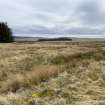
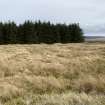
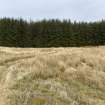


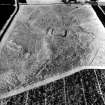
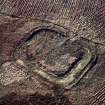
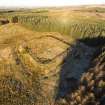
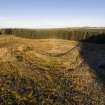
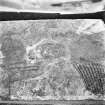
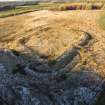

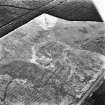

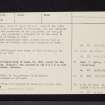
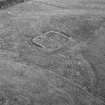
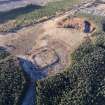
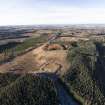
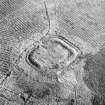

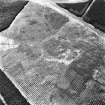
![Publication drawing: Castle Greg Roman fortlet. [Scan of photographic copy]](http://i.rcahms.gov.uk/canmore/s/SC00337292.jpg)
